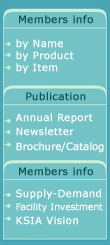 |
| |
Get the latest roadmap for semiconductor technology at SEMICON West 2005 in San Francisco.
|
SAN FRANCISCO, CA - For 40 years Moore¡¯s Law has accurately determined the rate of scaling in semiconductor devices. The International Technology Roadmap for Semiconductors (ITRS) has, in the last 14 years, had the job of determining what technologies are required to keep on the Moore¡¯s Law technology curve.The two will intersect at SEMICON West 2005, when the ITRS holds a public conference to solicit feedback for its 2005 update.
The ITRS technology working groups meet three times a year.in Europe, the U.S. and Asia.and each gathering coincides with a SEMICON exposition. Public meetings are usually held in the same timeframe to solicit feedback from non-ITRS participants. Such a public meeting is scheduled for July 13 at SEMICON West 2005. ¡°Without [the SEMICON expos] we wouldn¡¯t get near the attendance in terms of people coming to the public meetings,¡± said Robert R. Doering, cochair of International Roadmap Committee.
Up to 200 people in 16 groups are expected to participate in 2.days of workshops held prior to the public conference. The discussions, and public feedback from the conference, will form the basis for the 2005 ITRS update published in December.
Doering, who is a senior fellow, silicon technology development, at Texas Instruments, explained that the ITRS roadmap provides a ¡°snapshot of the current thinking of a pretty big group of people.¡± About 1,000 worldwide are involved in the process.This level of participation ¡°means you are getting something that has broad base of support, a worldwide consensus,¡± said Doering. ¡°On the other hand, it tends to be a little more conservative than what you would get if you pulled a small group of visionaries together,¡± he added. ¡°Hopefully it strikes a good balance.¡±
The roadmap has been a part of the industry since 1987, but wasn¡¯t always international. It started out as a national program focused on U.S. technology needs. As the semiconductor industry became more international during the 1990s, it became apparent that a roadmap just for the U.S. wouldn¡¯t be representative.
After going international, the next step was to involve the technology providers in the process.¡°We took a hard look at whether we had good distribution in terms of equipment and materials suppliers involved in the process,¡± said Doering. As well as including device makers and suppliers, the ITRS sought input from universities and government researchers. The result? ¡°It seems like they have gotten to the point where they (all sides) discuss issues and have a good process for consensus,¡± said Doering.
With the cost of some new chip making tools reaching tens of millions of dollars, economic issues are also now debated within some of the working groups, especially those concerned with lithography and IC test. Doering said that the ITRS hasn¡¯t yet determined how to use the economic data other than to influence ¡°our gut feeling. ¡°Looking at the economic factors is a first step,¡± he added.
What¡¯s different now is that there¡¯s more discussion from a top down level on how to include economic constraints in the roadmap process, explained Doering. ¡°We try and get more trends on our radar screen that have to do with the overall economics of the industry¡¦how we turn that kind of raw data into something that can help us determine what the technology of the future might look like.¡±
The day after the public meeting, Doering will give a keynote address as part of the ¡°Voices of the Industry¡± presentations at SEMICON West 2005. Doering said his keynote will emphasize the need for the industry to pay more attention to the long range technology outlook. To that end, the ITRS has introduced one new ¡°chapter,¡± focusing on the area of emerging research devices.
In the short term, Doering believes high-k gate dielectrics will remain a challenge for the semiconductor industry.¡° Will we be able to find something that is substantially better than the best we have today, which tends to be the nitrides and oxides? That¡¯s the biggest single [challenge],¡± he said.
Doering also believes that the limits to scaling CMOS will not arise from a shortage of ideas on how to get to smaller dimensions. Rather, ¡°it will just be that it doesn¡¯t make any sense to do that from a business point of view.¡±
The ITRS is sponsored by the European Semiconductor Industry Association (ESIA), the Japan Electronics and Information Technology Industries Association (JEITA), the Korean Semiconductor Industry Association (KSIA), the Semiconductor Industry Association (SIA), and Taiwan Semiconductor Industry Association (TSIA). International SEMATECH is responsible for global coordination for ITRS activities. |




